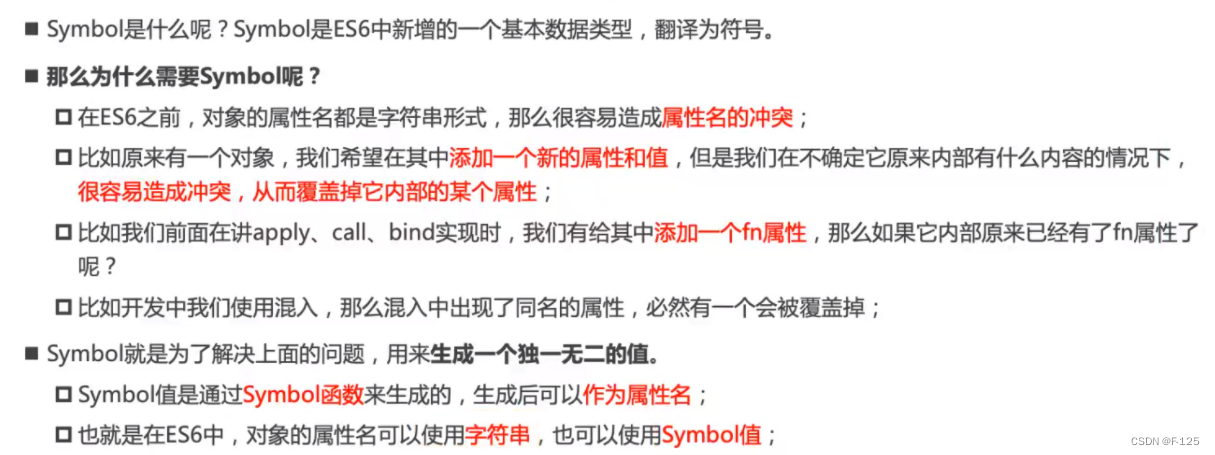1. 字面量增强
var name = "hgf"
var age = 20
var obj = {
// 1.property shorthand(属性的简写)
name,
age,
// 2.method shorthand(方法的简写)
foo: function() {
console.log(this)
},
bar() {
console.log(this)
},
baz: () => {
console.log(this)
},
// 3.computed property name(计算属性名)
[name + 123]: 'hehehehe'
}
2. 数组/对象的结构
// 数组结构
var names = ["abc", "cba", "nba"]
// var item1 = names[0]
// var item2 = names[1]
// var item3 = names[2]
// 对数组的解构: []
var [item1, item2, item3] = names
console.log(item1, item2, item3)
// 解构后面的元素
var [, , itemz] = names
console.log(itemz)
// 解构出一个元素,后面的元素放到一个新数组中
var [itemx, ...newNames] = names
console.log(itemx, newNames)
// 解构的默认值
var [itema, itemb, itemc, itemd = "aaa"] = names
console.log(itemd)
// 对象结构
var obj = {
name: "hgf",
age: 20,
height: 1.80
}
// 对象的解构: {}
var { name, age, height } = obj
console.log(name, age, height)
var { age } = obj
console.log(age)
var { name: newName } = obj
console.log(newName)
var { address: newAddress = "广州市" } = obj
console.log(newAddress) // "广州市"
3. let/const的基本使用
①let/const的定义:
let关键字:直观角度,let和var没有太大区别,都是用于声明一个变量;
const关键字:声明常量,表示保存的数据一旦被赋值,就不能再修改,如果赋值的是引用类型,那么可以通过引用找到对应的对象,修改对应的内容;
注意:let、const不允许重复声明变量;
②let/const的作用域提升:
我们知道var声明的变量会进行作用域提升,但是如果使用let/const声明的变量,在声明之前访问会报错;
③let/const和window关系:
在v8引擎中,是通过VariableMap的一个hashmap实现存储的;
④块级作用域的理解:
ES5中只有两个作用域
全局作用域
函数作用域
ES6中的{}具有块级作用域
注意:ES6的代码块{}作用域 对let/const/function/class 的声明的类型有效
对var声明无效
注意:function 特殊之处:函数还是没有块级作用域
// ES6的代码块级作用域
// 对let/const/function/class声明的类型是有效
{
let foo = "why"
function demo() {
console.log("demo function")
}
class Person {}
}
// console.log(foo) // foo is not defined
// 不同的浏览器有不同实现的(大部分浏览器为了兼容以前的代码, 让function是没有块级作用域)
// demo() // 输出 "demo function"
var p = new Person() // 报错Person is not definedif-switch_for块级作用域等语句ES6之后也有块级作用域;
⑤暂时性死区:
我们知道,在使用let、const声明变量时,在声明之前,变量都是不可以访问的,如果访问了会报错,而var声明的变量,在声明之前可以访问,只是值为undefined,不会报错。这就是let、const声明的变量与var声明的变量的不同之处之一,其实let、const声明的变量在代码编译阶段也是和var声明的变量一样,都创建了变量,只是let、const声明的变量在赋值之前都不可以访问,这种现象称之为暂时性死区。
4. 模板字符串的基本使用:
// ES6之前拼接字符串和其他标识符
const name = "hgf"
const age = 20
const height = 1.80
// console.log("my name is " + name + ", age is " + age + ", height is " + height)
// ES6提供模板字符串 ``
const message = `my name is ${name}, age is ${age}, height is ${height}`
console.log(message) // my name is hgf, age is 20, height is 1.80
5. ES6中函数的默认参数:
ES5以及之前给参数的默认值
0会被认为是false
// ES5以及之前给参数默认值
/**
* 缺点:
* 1.写起来很麻烦, 并且代码的阅读性是比较差
* 2.这种写法是有bug
*/
function foo(m, n) {
m = m || "aaa"
n = n || "bbb"
console.log(m, n)
}
foo(0, "") // 输出的时aaa bbb 传递参数0了被认为是falseES6的参数默认值写法:
// 1.ES6可以给函数参数提供默认值
function foo(m = "aaa", n = "bbb") {
console.log(m, n)
}
foo(0, "") // 0 "会输出空字符 "对参数和默认值的解构:
// 2.对象参数和默认值以及解构
function printInfo({name, age} = {name: "hgf", age: 20}) {
console.log(name, age)
}
printInfo({name: "kobe", age: 40}) // kobe 40
6. ES6中的函数的剩余参数:
function foo( m, n, ...args) {
console.log(m, n)
console.log(args)
console.log(arguments)
}
foo(20, 30, 40, 50, 60) //20, 30, 40, 50, 60剩余参数与arguments的区别:
①剩余参数只包含那些没有对应形参的实参,而arguments对象包含了传给函数的所有实参;
②arguments对象不是一个真正的数组,而rest参数是一个数组,可以进行数组的所有操作;
③arguments是早期的ECMAScript中为了方便去获取所有的参数提供了一个数据解构,而rest参数是ES6中提供并希望代替arguments;
7. 箭头函数的补充:
箭头函数没有显示原型prototype, 也没有this,arguments从上层找;
8. 展开语法:
展开运算符进行的是一个浅拷贝过程
const names = ["abc", "cba", "nba"]
const name = "hgf"
const info = {name: "hgf", age: 18}
// 1.函数调用时
function foo(x, y, z) {
console.log(x, y, z)
}
// foo.apply(null, names)
foo(...names) // abc cba nba
foo(...name) h g f
// 2.构造数组时
const newNames = [...names, ...name]
console.log(newNames) // [abc, cba, nba, h, g, f[
// 3.构建对象字面量时ES2018(ES9)
const obj = { ...info, address: "广州市", ...names }
console.log(obj)
输出: // {
'0': 'abc',
'1': 'cba',
'2': 'nba',
name: 'hgf',
age: 18,
address: '广州市'
}9. ES6表示数值的方式:
const num1 = 100 // 十进制
// b -> binary
const num2 = 0b100 // 二进制
// o -> octonary
const num3 = 0o100 // 八进制
// x -> hexadecimal
const num4 = 0x100 // 十六进制
console.log(num1, num2, num3, num4)
// 大的数值的连接符(ES2021 ES12)
const num = 10_000_000_000_000_000
console.log(num)10. ES6的新增数据类型Symbol的基本使用:

// 2.ES6中Symbol的基本使用
const s1 = Symbol()
const s2 = Symbol()
console.log(s1 === s2)
// ES2019(ES10)中, Symbol还有一个描述(description)
const s3 = Symbol("aaa")
console.log(s3.description)
// 3.Symbol值作为key
// 3.1.在定义对象字面量时使用
const obj = {
[s1]: "abc",
[s2]: "cba"
}
// 3.2.新增属性
obj[s3] = "nba"
// 3.3.Object.defineProperty方式
const s4 = Symbol()
Object.defineProperty(obj, s4, {
enumerable: true,
configurable: true,
writable: true,
value: "mba"
})
console.log(obj[s1], obj[s2], obj[s3], obj[s4])
//false
//aaa
//abc cba nba mba